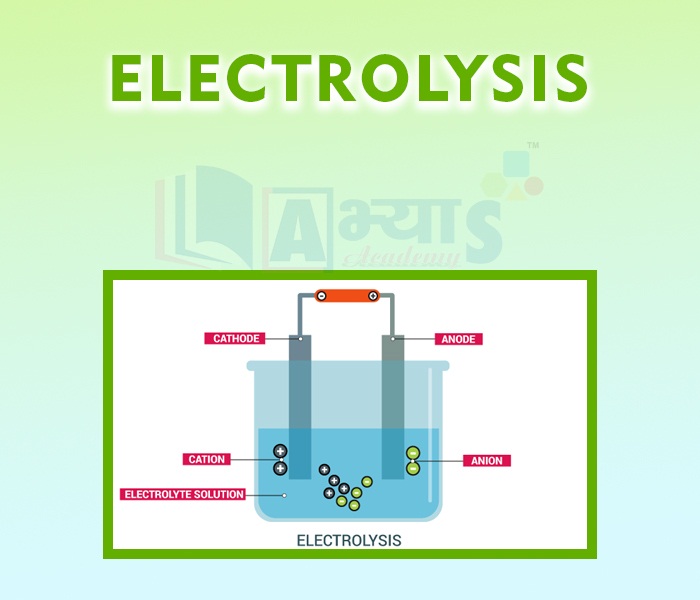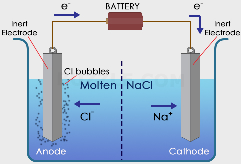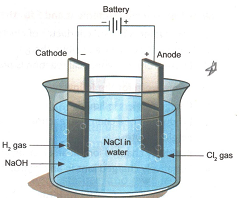Electrolysis

Electrolysis
Electrolysis:
|
In the diagram, rods are made of conducting material (called electrodes). The electrode connected to the negative terminal of battery is called cathode and the one connected to positive terminal of battery is called anode. The liquid that conducts electricity because of presence of ions is called electrolyte. Examples are: salt solution, dilute solution of acids. A process called electrolysis occurs in an electrolytic cell when a current is passed through the electrolyte. |
 |
The production of a chemical reaction by passing an electric current through an electrolyte is called electrolysis. An electrolyte contains ions, which are charged. The positively charged ions are called cations, because they are attracted to the cathode, and the negatively charged ones are called anions, because they are attracted to the anode. We know that unlike charges attract and like charges repel. A chemical reaction takes place at the anode and the cathode. This can be observed as formation of bubbles or decomposition of metal on electrodes.
The oxygen bubbles are formed on the electrode (called anode) connected to the positive terminal of the battery and hydrogen bubbles are formed on the other electrode (called cathode) connected to the negative terminal of the battery.
We thus, conclude that the passage of an electric current through an ionic solution causes chemical changes.
 |
 |
Faraday's laws of electrolysis are related to ________________ | |||
| Right Option : B | |||
| View Explanation | |||
In electrolysis ______________________ | |||
| Right Option : B | |||
| View Explanation | |||
Charges always occur | |||
| Right Option : A | |||
| View Explanation | |||
Students / Parents Reviews [10]
It was good as the experience because as we had come here we had been improved in a such envirnment created here.Extra is taught which is beneficial for future.

Eshan Arora
8thOne of the best institutes to develope a child interest in studies.Provides SST and English knowledge also unlike other institutes. Teachers are co operative and friendly online tests andPPT develope practical knowledge also.

Aman Kumar Shrivastava
10thMy experience with Abhyas is very good. I have learnt many things here like vedic maths and reasoning also. Teachers here first take our doubts and then there are assignments to verify our weak points.

Shivam Rana
7thMy experience was very good with Abhyas academy. I am studying here from 6th class and I am satisfied by its results in my life. I improved a lot here ahead of school syllabus.

Ayan Ghosh
8thBeing a parent, I saw my daughter improvement in her studies by seeing a good result in all day to day compititive exam TMO, NSO, IEO etc and as well as studies. I have got a fruitful result from my daughter.

Prisha Gupta
8thIt has a great methodology. Students here can get analysis to their test quickly.We can learn easily through PPTs and the testing methods are good. We know that where we have to practice

Barkha Arora
10thIt was a good experience with Abhyas Academy. I even faced problems in starting but slowly and steadily overcomed. Especially reasoning classes helped me a lot.

Cheshta
10thAbhyas is a complete education Institute. Here extreme care is taken by teacher with the help of regular exam. Extra classes also conducted by the institute, if the student is weak.

Om Umang
10thA marvelous experience with Abhyas. I am glad to share that my ward has achieved more than enough at the Ambala ABHYAS centre. Years have passed on and more and more he has gained. May the centre flourish and develop day by day by the grace of God.

Archit Segal
7thMy experience with Abhyas academy is very good. I did not think that my every subject coming here will be so strong. The main thing is that the online tests had made me learn here more things.








